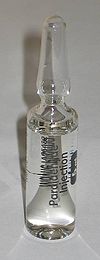Paraldehyde
 | |
 | |
| Clinical data | |
|---|---|
| Pregnancy category |
|
| Routes of administration | Oral/Rectal/Injection |
| ATC code | |
| Legal status | |
| Legal status |
|
| Identifiers | |
| |
| CAS Number | |
| CompTox Dashboard (EPA) | |
| ECHA InfoCard | 100.004.219 |
| Chemical and physical data | |
| Formula | C6H12O3 |
| Molar mass | 132.16 g·mol−1 |
Paraldehyde is the cyclic form of three acetaldehyde molecules (a trimer). A colourless to pale yellow pungent liquid, it is sparingly soluble in water and highly soluble in alcohol. It has industrial and medical uses. It was first synthesized in 1829 by Wildenbusch. Paraldehyde decomposes in air, turning brown and producing an odour of acetic acid (and must then be disposed of). It quickly reacts with most plastics and rubber.
Medical applications
| Toxicity | Oral rat LD50: 2711 mg/kg |
| Chemical Properties | |
| Solubility in water | 1 in 10 |
| Melting point | 12.5 C |
| Boiling point | 124 C |
| Flash point | 27.5 C |
| Specific gravity | 0.995 |
Paraldehyde was introduced into clinical practice in the UK by the Italian physician Vincenzo Cervello in 1882. It is a CNS depressant and was soon found to be an effective anticonvulsant, hypnotic and sedative. It was included in some cough medicines as an expectorant (though there is no known mechanism for this function beyond the placebo effect). It was commonly used to induce sleep in sufferers from delirium tremens but has been replaced by other drugs in this regard. It is one of the safest hypnotics and was regularly given at bedtime in psychiatric hospitals and geriatric wards up to the 1960s. Up to 30% of the dose is excreted via the lungs (the rest via the liver). This contributes to a strong unpleasant odour on the breath.
Today, paraldehyde is sometimes used to treat status epilepticus. Unlike diazepam and other benzodiazepines, it does not suppress breathing at therapeutic doses and so is safer when no resuscitation facilities exist or when the patient's breathing is already compromised.[1] This makes it a useful emergency medication for parents and other carers of children with epilepsy. Since the dose margin between the anticonvulsant and hypnotic effect is small, paraldehyde treatment usually results in sleep.
Generic paraldehyde is available in 5ml sealed glass ampoules. The tradename in the US is Paral®.

Administration
Paraldehyde has been given orally, rectally, intravenously and by intramuscular injection. It reacts with rubber and plastic which limits the time it may safely be kept in contact with some syringes or tubing before administration.
- Injection. Intramuscular injection can be very painful and lead to sterile abscesses, nerve damage, and tissue necrosis. Intravenous administration can lead to pulmonary edema, circulatory collapse and other complications.
- Oral. Paraldehyde has a hot burning taste and can upset the stomach. It is often mixed with milk or fruit juice in a glass cup and stirred with a metal spoon.
- Rectal. It may be mixed 1 part paraldehyde with 9 parts saline or, alternatively, with an equal mixture of Arachis or olive oil. This mixture cannot be made up in advance, which delays administration.
Industrial applications
Paraldehyde has numerous alternate chemical names including paracetaldehyde, s-trimethyltrioxymethylene, and trimethyl-1,3,5-trioxane. Paraldehyde is used in resin manufacture, as a preservative, and in other processes as a solvent.
References
- ^ Norris E, Marzouk O, Nunn A, McIntyre J, Choonara I (1999). "Respiratory depression in children receiving diazepam for acute seizures: a prospective study". Dev Med Child Neurol. 41 (5): 340–3. PMID 10378761.
{{cite journal}}: CS1 maint: multiple names: authors list (link)
- Paraldehyde Injection B.P Data Sheet
- Drugs.com: Paraldehyde
- A Practical Treatise on Materia Medica and Therapeutics by Robers Bartholow. 1887.
- British National Formulary Edition 50.
- Paraldehyde Chemical Data
